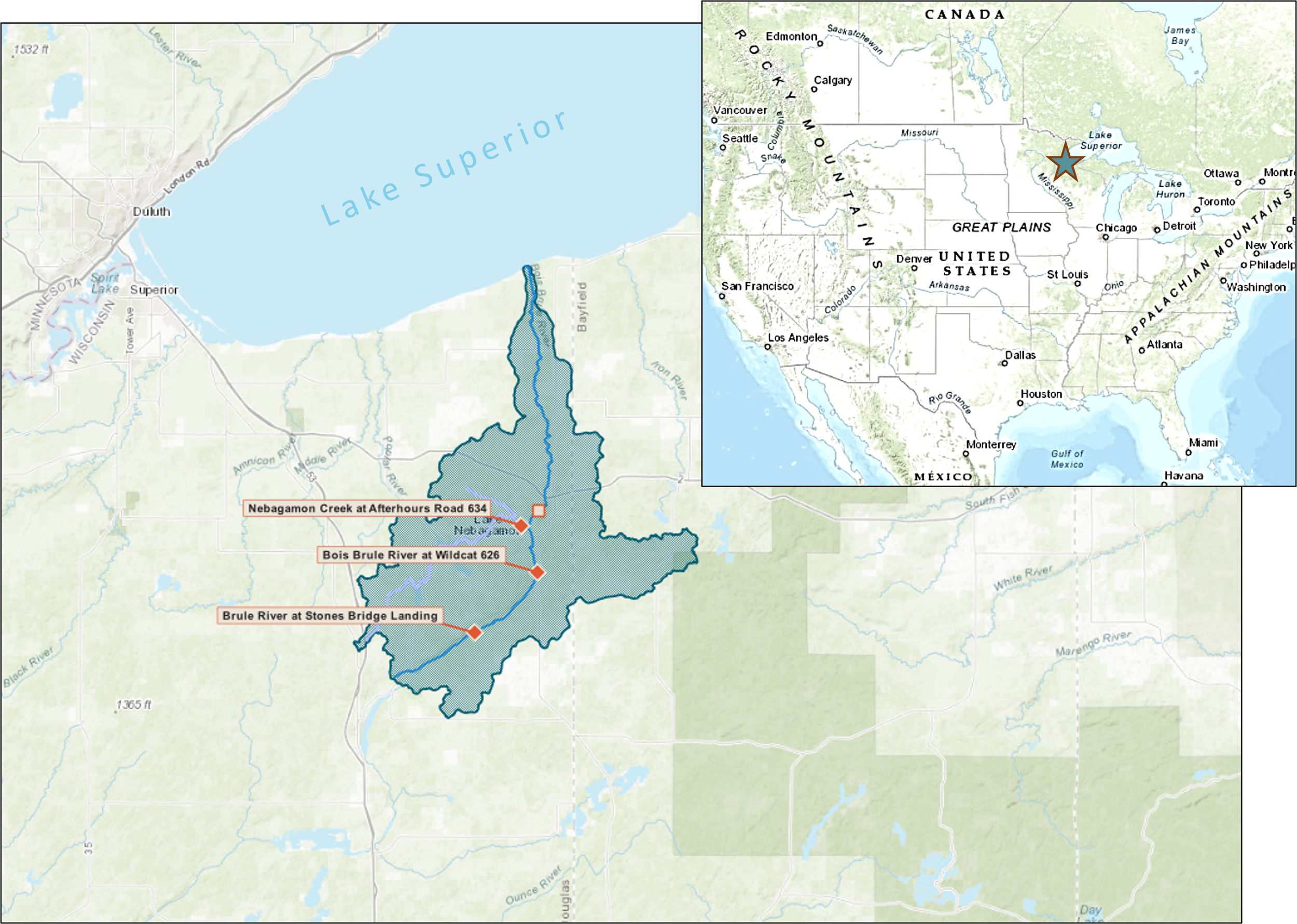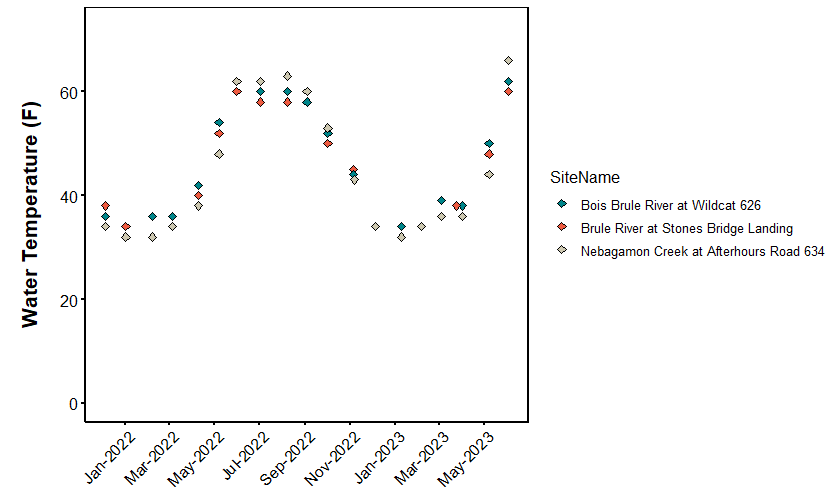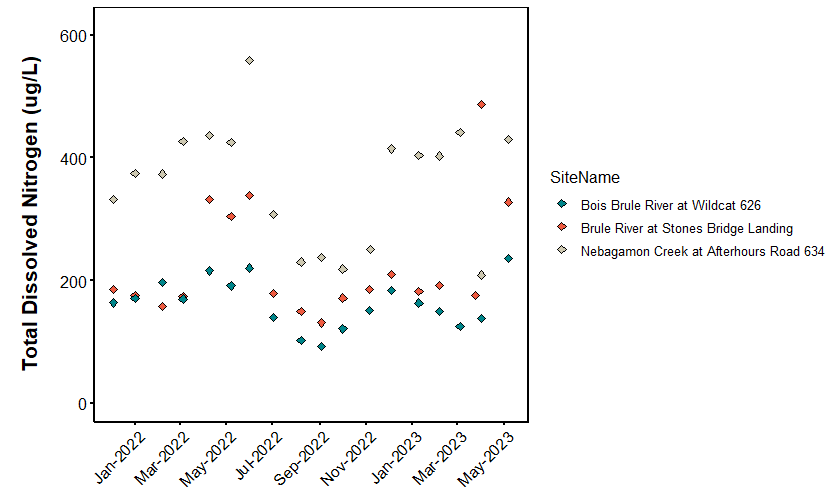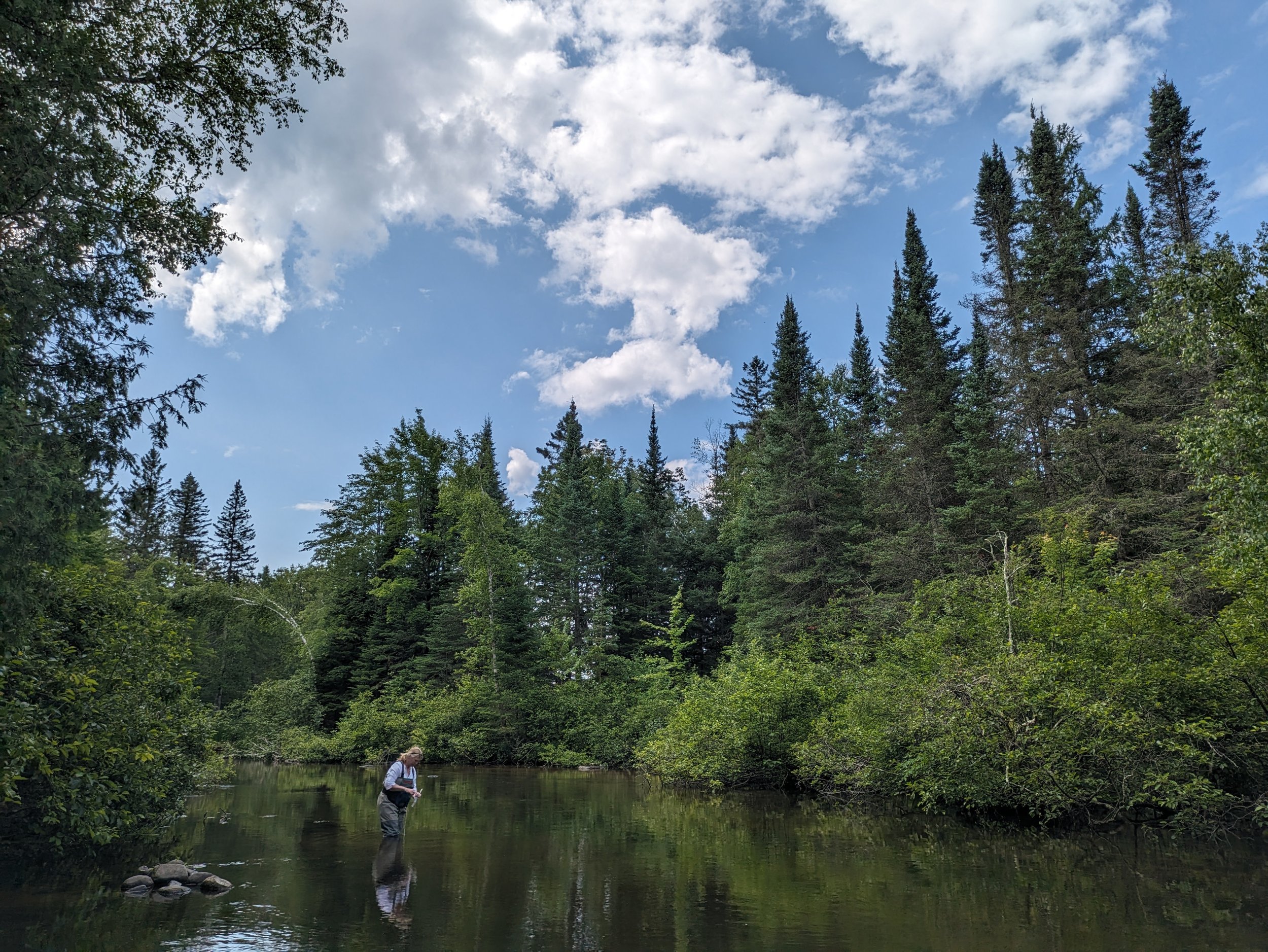Volunteer Spotlight: Amy Abrams
An interview with community scientist Amy Abrams of Wisconsin.
Amy Abrams samples the Bois Brule River in Wisconsin. Photo: Andrea Norton
Amy Abrams began sampling for Science on the Fly in November of 2021 after taking over the locations from Bob Banks who was the original sampler. Since then, she has collected samples monthly on the Bois Brule river in Wisconsin. Amy recently retired from being a film assistant in Los Angeles and relocated back to Wisconsin where she now lives in a renovated cabin on the Brule. Science on the Fly is fortunate for all the hardwork Amy has done for our program and recently we were able to meet her in person, explore the Brule river, and share the data. Here’s an interview with Amy Abrams.



Above, a map of Amy’s sampling locations along with water temperature readings and Total Dissolved Nitrogen concentrations from her analyzed dating January 2022 to May 2023. Sampling data from all volunteers can be reviewed on our public data sheet, and relative concentrations of nitrate, phosphate, and dissolved organic carbon are available on our interactive maps. Credit: Andrea Norton
An Interview with Amy
What is your Name? What State are you From? What Local river do you Sample?
My name is Amy Holbrook Abrams and I live in Northern Wisconsin on the Bois Brule River. This is the river that I sample for Science on the Fly.
What is your background?
I moved to the Brule River in 2018 after retiring from a 26 year career in the Motion Picture Industry. I was a Camera Assistant with the IATSE Local 600 for 21 of the 26 years in that Industry.
What is your background in fishing and river science?
I learned how to Fly Fish when I was five years old just before my very first trip to the Brule River to visit my grandfather. My mother was an exceptional Fly Fisher-woman. She had me out under the Rhododendron bushes in our front yard practicing my cast with yarn attached to a stick …”back stop, forward stop” “10 o’clock, 2 o’clock”. I caught my first little Brookie right off of our landing. The Brule has been part of my life and dear to my heart ever since. So much so that when I retired from the Film Industry and thought about where I wanted to move to next, the Brule River was what called to me. I was extremely fortunate that a cabin came up for sale. Every day here brings me joy. And I am always learning about something new about it’s history and ecosystem.
Amy taking a 60 mL sample of filtered water from the Bois Brule River. Photo credit: Andrea Norton
Tell us about your local river, the Bois Brule.
The Bois Brule River has a long and excellent history as a pristine trout stream. It is a beautiful 44 mile river. Diverse in it’s flora and fauna. Truly a unique and special place that many generations of families have worked hard to protect. https://bruleriverpreservation.org/the-brule-river-video/
The Bois Brule River Valley and the uppermost St. Croix River Valley were carved by meltwater flowing south from glacial Lake Superior and the surrounding uplands. When the glaciers receded, a divide formed out of which the Brule and St. Croix rivers flow today…in opposite directions, with the Brule River flowing north into Lake Superior. A portage was established between the two rivers and was used by early native people then European explorers, traders trappers and missionaries. In the mid 1800’s, especially after the Civil War, people began to recognize the Brule area as a recreational resource.” (I am using the DNR websites information here because it is succinct). This was when my great great grandfather Arthur Holbrook found the Bois Brule, in 1878 when he and three friends came to hunt, fish and camp.
Why did you want to get involved with Science on the Fly?
I came to Science on the Fly through my friend and neighbor, Bob Banks, who had signed up to do the sampling but was going out of the country for three months so handed the project over to me! I was immediately intrigued and excited to be doing something important for the river. I’ve continued to sample monthly since November 2021!
You recently received some of your Bois Brule River data back. What are your first thoughts after reviewing it?
Ha! My first thought was, I need someone to explain this to me! I do not have a background in science and so it’s a bit difficult to understand what the test results might mean for the river but hopefully I will become more proficient in understanding what the different results mean over the course of the next few years. I was very interested to see the increase in water temperature shift from when I began testing—a startling change in so short a time. Andie also found some interesting results that need to be watched in the next year to see if it was a one off, or something to be more concerned about. I am also going to move my sampling to the upstream side of the two bridges so I can avoid any abnormal readings from road contaminants.
What do you think is the biggest concern for the Brule River?
I am most concerned that there is no wholistic approach to preserving this pristine river. After the DNR was restructured, the emphasis was placed on maximizing logging in the river valley without any kind of study or understanding of the ramifications would be by removing larger areas of timber than previously planned and how that could or would have on the watershed. There was a significant increase in logging since I moved to the River in 2018. It is part of what the DNR calls the “Master Plan” but the increase was mandated to raise revenue for the State…Often logging occurs right up to the edge of tributaries without any effort to protect those streams. In some parts of the upper river where these tributaries enter the river, temperatures have risen precipitously. Sediment has poured into the river but with dryer than normal summers, that sediment is building up and not moving out of the river, blocking important gravel beds for trout. The increase in water temperature is especially concerning. It does seem to be a very critical time to be monitoring the river.
What is your biggest take away since sampling with Science on the Fly?
How very important it is to do this sampling. Even if other people may not see the benefit yet, I think it is critically important to monitor as long as I can. The river does feel fragile.
What efforts can others do to better protect their rivers?
Pay attention and try to stay involved at a local level in whatever way you can. My uncle always encouraged me to keep a phenological journal and I have been doing that as consistently as I can. I hope that information can be useful in the future.
Thank you, Amy for all your efforts in telling the story of our rivers!
Daily recreation on the Bois Brule River in the month of July. Photo credit: Andrea Norton
The sampling on the Bois Brule river has been supported by the local Brule River Preservation. If you would like to support our sampling efforts on the Bois Brule and other rivers around the world, consider sponsoring a river or donating directly to our program!


